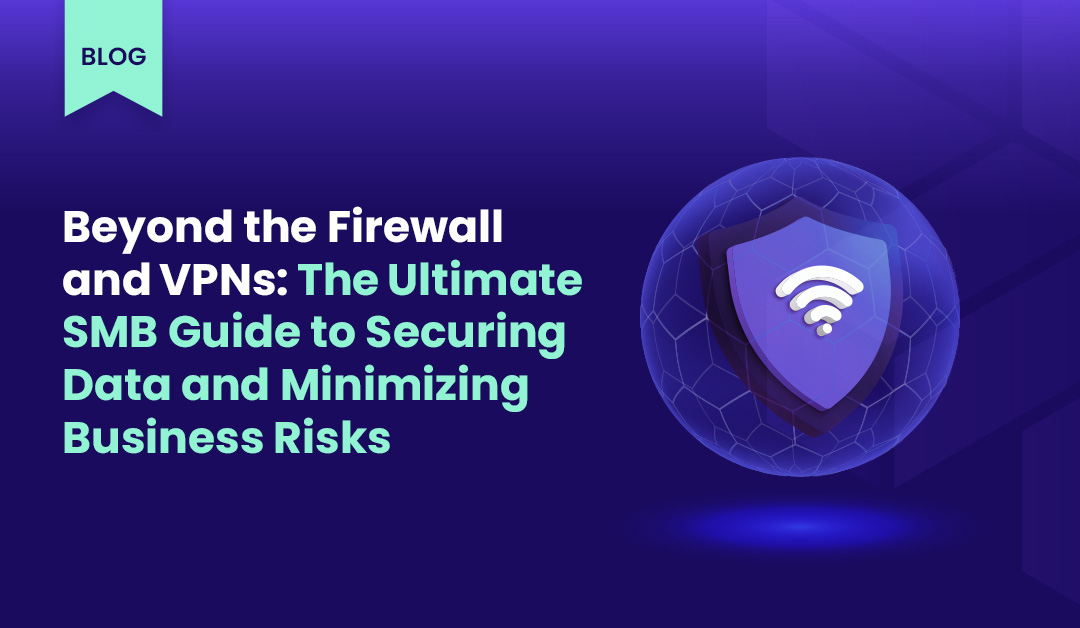Beyond the Firewall and VPNs: The Ultimate SMB Guide to Securing Data and Minimizing Business Risks
Is your SMB still relying on firewalls and VPNs to secure data? Learn why these tools are no longer enough and discover how SASE can minimize business risks and provide modern, cloud-based security for your distributed team.
Author
Date
Category
All Categories
- AI-powered security
- Attacks & Threats
- Cybersecurity
- Hybrid Cloud
- Network
- Network Firewall
- Network Protection
- News
- Remote Workforce
- Security
- Zero Trust
Contents
Popular Posts
Product
Join the Newsletter

If you’re an SMB leader in 2025 still relying on firewalls and VPNs to secure your network, this one’s for you.
The tools that once worked are now the very reason attackers get in. Firewalls were built for a perimeter that doesn’t exist anymore. VPNs were designed for a workforce that stayed put. But your business has evolved—your people work from coffee shops, client sites, airports, and home offices. Your data is scattered across SaaS apps, cloud drives, and devices you don’t even know about.
That’s why modern cybersecurity for SMBs requires a new mindset: one that assumes attackers are already inside, and that trusts nothing and no one until verified. This is where Secure Access Service Edge (SASE) comes in.
Why SMBs Are the New Favorite Target
Cyberattacks used to be reserved for big names. Not anymore. SMBs now make up over 60% of breach victims, according to recent industry reports. Why? Because they’re easier to breach, often lack in-house security teams, and are more likely to pay ransoms to get back to business.
We’ve seen a massive spike in attacks leveraging stolen VPN credentials, outdated firewall rules, and unmanaged endpoints. If you’re still handing out VPN logins like Halloween candy and hoping your firewall catches everything—it’s only a matter of time.
Want to dive deeper? Read: How VPN Credentials are Stolen with Social Engineering
SASE: What It Is and Why It’s a Must for SMBs
Secure Access Service Edge (SASE) is not a buzzword. It’s a practical framework that combines zero trust network access (ZTNA), secure web gateway (SWG), firewall-as-a-service (FWaaS), and cloud access security broker (CASB)—all delivered from the cloud.
But here’s what it really means for SMBs:
- No more flat networks. Every user and device is segmented. You control who accesses what and when.
- No more VPN sprawl. Users get secure access to just what they need—with continuous checks behind the scenes.
- No more blind spots. SASE gives you real-time visibility across apps, devices, and users, even on unmanaged networks.
- No more security silos. All policies are enforced from a single control point—your SASE platform.
The result? Less risk, fewer alerts, and a much smaller chance of waking up to an encrypted server and a ransom note.
The Hidden Risks of Firewalls and VPNs for SMBs
Let’s get specific. These are the risks you’re likely exposing your business to right now:
- VPN credentials are low-hanging fruit. Most attacks in SMBs start with credential theft. Once inside, attackers move laterally across the network—something firewalls can’t stop.
- No visibility into remote users. If someone connects from a compromised laptop in a hotel lobby, would you even know?
- Static access policies. Traditional tools assume once you’re in, you’re trusted. That’s a dangerous assumption.
- Compliance nightmares. Many privacy frameworks (HIPAA, GDPR, CCPA) require stronger access controls than legacy tools can offer.
Read this next if you want to dig deeper into the approach: ZTNA: A Proactive Approach to Cybersecurity for SMBs
What a Modern SMB Stack Should Look Like in 2025
A security stack in 2025 should be:
- Cloud-delivered
- Device-aware
- Identity-first
- Policy-driven
- Designed for distributed teams and data
That’s what Timus SASE delivers out of the box. And we built it specifically for MSPs and SMBs—not retrofitted from enterprise leftovers.
You get:
- ZTNA to replace VPNs
- Built-in device posture checks
- DNS security and web filtering
- One-click integrations with Microsoft 365, Google Workspace, and more
- MSP-friendly management console
And it doesn’t hurt that setup takes hours, not weeks.
Learn how it works here: Zero Trust Security Made Simple: How Timus SASE Safeguards Small and Mid-Sized Businesses
What You Can Do Today to Start Minimizing Risk
You don’t need to rip and replace everything tomorrow. But here are 5 steps every SMB should take now:
- Audit your current access model. How are users getting into your systems and apps? Who has access to what? What happens if their device is compromised?
- Eliminate legacy VPNs. If you’re still using shared credentials or split tunneling, you’re at risk.
- Enforce MFA everywhere. And not just for users—include administrators and third-party vendors.
- Segment your network. Limit blast radius. Users shouldn’t be able to see or access everything by default.
- Talk to your MSP or IT provider about SASE. Ask if they’re offering ZTNA, DNS filtering or safe browsing, or real-time device posture checks.
Need help? This guide is a great place to start: How MSPs Can Build Trust and Long-Term Relationships with SMBs
Real SMBs, Real Stories
We’ve worked with dozens of MSPs who’ve moved their clients off VPNs and firewalls onto Timus SASE. One example? A 40-person insurance firm in Ohio. They had three offices and a half-baked VPN setup. After one credential theft incident, they implemented Timus SASE. Since then:
- Access is based on user identity and device posture.
- Compliance reporting is automated.
- The number of phishing-based support tickets dropped by 70%.
And they didn’t need a dedicated IT person to manage it.
Final Thoughts: SMB Security Needs to Be Proactive, Not Reactive
The reality is: small and mid-sized businesses can no longer afford to play catch-up with cybersecurity. You are a target. And firewalls and VPNs are not going to protect you anymore.
The good news? Tools like SASE aren’t just for the Fortune 500. They’re accessible, affordable, and easy to manage—especially when built for the SMB market like Timus SASE.
So if you’re still relying on legacy tools to protect your modern business, it’s time to take a hard look at how your security stack matches up to the threats of today.
Because beyond the firewall is where real security starts.
Want to see how Timus SASE could work for your business?
Book a demo or read more on our blog page for practical guidance, real stories, and security best practices built for SMBs and MSPs.
FAQ
Traditional firewalls and VPNs were designed for a time when users and data stayed inside a clearly defined perimeter. In today’s environment—with remote work, cloud apps, and mobile devices—those tools create blind spots. VPNs, in particular, are vulnerable to stolen credentials and provide overly broad access once a user is inside. Without visibility into user behavior or device posture, SMBs relying solely on these tools are exposed to modern threats.
SASE (Secure Access Service Edge) is a cloud-delivered cybersecurity framework that combines multiple technologies—like Zero Trust Network Access (ZTNA), firewall-as-a-service (FWaaS), and secure web gateways (SWG)—to enforce access controls and security policies based on identity, device health, and context. For SMBs, this means better visibility, reduced risk, and stronger protection across users, apps, and networks, without needing a patchwork of tools.
SASE replaces VPNs by using identity- and posture-based policies to grant users access only to the resources they need—nothing more. It continuously evaluates the security status of the user and device, ensuring access is safe and compliant in real-time. This reduces the attack surface and eliminates the risks associated with shared or static VPN credentials.
Not at all. Modern SASE platforms like Timus are built specifically for SMBs and their MSPs. They’re designed to be simple to deploy, easy to manage, and cost-effective. You don’t need to rip and replace your entire tech stack overnight. You can start small—by replacing VPNs —and scale as needed.
Start by auditing how users access your systems, who has access to what, and how secure their devices are. Replace any legacy VPN setups with a SASE-based solution. Make sure multi-factor authentication is enforced everywhere, segment your network to reduce risk, and talk to your MSP or IT provider about implementing Zero Trust access controls.
Get Started with Timus
Zero Trust. Adaptive Cloud Firewall. Secure Remote Access. In one.
